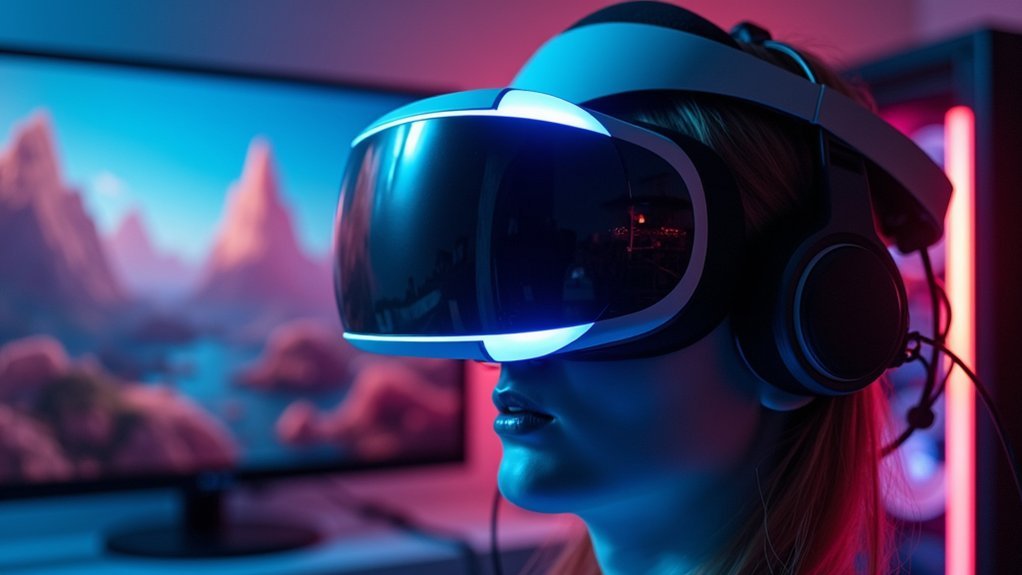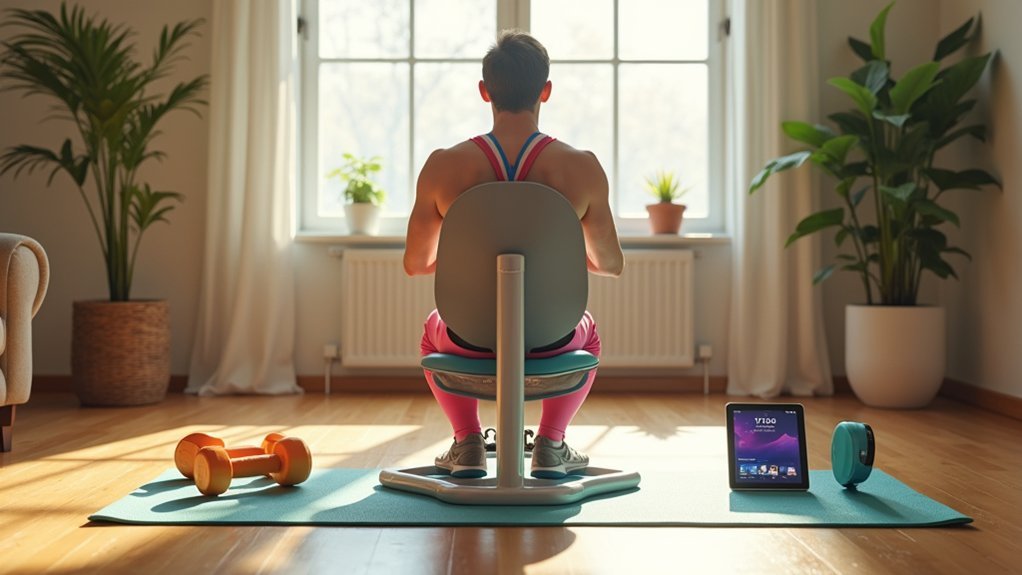You’ll experience dramatically superior graphics with tethered VR headsets because they harness desktop-grade GPUs and CPUs that deliver 90-120+ FPS with real-time ray tracing capabilities. These systems feature high-resolution displays of 1440×1600 pixels per eye or greater, while HDMI/DisplayPort connections provide uncompressed visuals without bandwidth limitations. The external hardware enables advanced physics simulations, sophisticated lighting effects, and massive memory pools for complex textures that standalone headsets simply can’t match—and there’s much more to this technological advantage.
Processing Power Advantage Through External Hardware Connection

When you connect a tethered headset to your PC or gaming console, you’re fundamentally borrowing the computational muscle of desktop-grade hardware that standalone devices simply can’t match.
This external hardware connection releases processing power that transforms your VR experience entirely. High-performance CPUs handle complex calculations while dedicated GPUs render superior graphics with remarkable precision.
You’ll notice the difference immediately through advanced physics simulations that respond naturally to your movements.
Tethered headsets leverage graphics APIs like DirectX 12 and Vulkan, delivering enhanced visual fidelity that creates truly detailed environments.
This processing advantage enables real-time rendering of complex textures and lighting effects, resulting in an immersive experience that standalone headsets struggle to achieve due to their limited onboard hardware constraints.
Enhanced GPU Performance and Desktop-Grade Graphics Cards
Desktop-grade graphics cards stand as the powerhouse behind tethered headsets’ superior visual performance, delivering rendering capabilities that mobile processors can’t approach. When you’re using powerful GPUs, you’ll experience enhanced graphics processing that transforms your virtual worlds into stunningly realistic environments with exceptional visual fidelity.
| Feature | Tethered Headsets | Standalone VR |
|---|---|---|
| GPU Type | Desktop RTX/RX Series | Mobile Chipsets |
| Ray Tracing | Real-time ray tracing | Limited/None |
| Frame Rates | 90-120+ FPS | 60-90 FPS |
These advanced rendering techniques enable immersive experiences with complex textures and detailed lighting effects. High frame rates markedly reduce motion sickness during extended sessions, while broader API support allows developers to create sophisticated graphical applications optimized specifically for tethered systems.
Higher Resolution Displays and Frame Rate Capabilities

While standalone headsets continue improving their visual capabilities, tethered systems deliver substantially higher resolution displays that typically feature 1440 x 1600 pixels per eye or greater, creating remarkably sharp and detailed virtual environments.
You’ll experience enhanced visual clarity that makes complex textures appear crisp and lifelike during your sessions.
These tethered headsets support frame rates up to 120Hz or higher, ensuring smoother visuals and eliminating motion blur during rapid movements.
The superior graphics processing capabilities enable rendering of intricate details that create truly immersive experiences. You’ll also benefit from lower latency between your movements and visual updates, making interactions feel instantaneous.
Advanced display technologies like OLED screens provide exceptional color accuracy and contrast, particularly beneficial for VR training simulations requiring precise visual representation.
Advanced Visual Effects and Real-Time Rendering Quality
You’ll notice tethered headsets deliver stunning visual effects that standalone devices simply can’t match, thanks to their access to desktop GPU power that handles complex lighting, shadows, and particle systems with ease.
The low latency processing eliminates the jarring delays that break immersion, ensuring every visual element renders smoothly in real-time.
When you’re experiencing complex physics simulations—like fluid dynamics or destructible environments—tethered systems maintain consistent performance without compromising visual quality.
Desktop GPU Power
Two critical advantages distinguish tethered headsets from their standalone counterparts: access to high-end desktop GPUs and the processing power they deliver.
You’ll experience dramatically superior performance when your headset taps into NVIDIA’s RTX 30 series or AMD’s Radeon RX 6000 series cards, which offer exponentially more computational muscle than mobile processors.
This desktop GPU power enables real-time rendering at higher resolutions like 4K, delivering an immersive experience with advanced visual effects including ray tracing.
You’ll notice enhanced lighting, realistic reflections, and detailed textures that create truly complex simulations.
The high bandwidth and low latency of wired connections guarantee your powerful desktop hardware translates directly into smoother visuals, reduced motion blur, and refresh rates exceeding 120Hz—performance levels standalone headsets simply can’t match.
Low Latency Processing
Beyond raw computational power, tethered headsets excel at minimizing the delay between your physical movements and corresponding visual updates on screen. Low latency processing guarantees your head turns and gestures translate instantly into visual feedback, creating a truly immersive experience during complex simulations. This seamless synchronization prevents motion sickness and maintains presence in virtual environments.
Tethered systems leverage high-end desktop-grade GPUs to deliver superior graphics while maintaining peak performance. You’ll experience advanced visual effects like dynamic lighting without compromising frame rates.
The optimization capabilities of these powerful processors enable real-time rendering at higher resolution displays, guaranteeing every detail appears crisp and responsive. This combination of processing speed and visual fidelity makes tethered headsets ideal for professional training scenarios where precision matters most.
Complex Physics Simulations
Complex physics simulations represent where tethered headsets truly showcase their superiority over standalone alternatives.
You’ll experience real-time physics simulations that deliver accurate collision detection and object interactions, creating genuinely responsive environments. Your powerful PC processes complex training scenarios with intricate details that wouldn’t be possible otherwise.
These tethered headsets leverage desktop-grade GPUs to render advanced visual effects like dynamic lighting, shadows, and particle systems simultaneously.
You’re getting higher performance that translates into more realistic simulations where objects behave exactly as they should. The immersive experience becomes profound when physics calculations don’t compromise visual quality.
High-fidelity visuals combined with accurate physics create training environments that feel authentic.
You’ll notice how objects respond naturally to your interactions, making complex scenarios more engaging and educational than simplified standalone alternatives.
Low Latency Data Transfer and Bandwidth Benefits
When you’re using a tethered VR headset, you’ll experience lightning-fast data transmission through HDMI or DisplayPort connections that wireless systems simply can’t match.
This high-speed wired connection provides massive bandwidth capacity that enables your headset to receive complex visual data without compression or quality loss.
You’ll notice the difference immediately in how responsive your VR environment feels, as the superior bandwidth eliminates the bottlenecks that typically plague wireless alternatives.
High-Speed Data Transmission
Since tethered headsets rely on direct wired connections like DisplayPort or HDMI, they deliver exceptional high-speed data transmission that wireless alternatives can’t match.
This superior bandwidth enables you to experience stunning visual quality without compromising performance.
Here’s what high-speed data transmission brings to your VR experience:
- Crystal-clear visuals – You’ll see high-resolution images and complex graphics rendered without compression or degradation.
- Real-time responsiveness – Low latency guarantees your visual feedback matches your movements instantly.
- Advanced graphics – Real-time lighting and sophisticated rendering techniques create realistic environments.
- Smooth frame rates – Support for 90+ FPS maintains fluid motion during fast-paced interactions.
- Enhanced immersion – The combination delivers an immersive experience that keeps you engaged without motion sickness.
Tethered headsets maximize your VR potential through uncompromised data flow.
Bandwidth Capacity Advantages
While wireless VR technology continues advancing, tethered headsets maintain a vital edge through their superior bandwidth capacity that fundamentally transforms your visual experience.
You’ll benefit from high-bandwidth data transfer that enables markedly more detailed graphics and complex visual effects than wireless alternatives can deliver. This enhanced processing power allows your system to render real-time lighting, realistic shadows, and intricate textures without compromise.
The stability of wired connections guarantees consistent performance during demanding applications, eliminating bandwidth fluctuations that plague wireless setups. When you’re experiencing intensive VR scenarios, this reliability becomes essential for maintaining an immersive experience.
Tethered headsets leverage your PC’s full graphical capabilities, delivering the superior visual fidelity that truly showcases VR’s potential.
External Tracking Systems for Improved Visual Accuracy
Although standalone headsets have made significant strides in tracking capabilities, tethered headsets take visual accuracy to the next level through sophisticated external tracking systems.
You’ll experience precise motion tracking through infrared or laser technology that delivers superior graphics performance with minimal latency issues.
- Base stations provide room-scale tracking – Multiple external sensors create larger play areas for complex simulations
- Real-time position updates – Your movements translate instantly into the virtual environment for an immersive experience
- Enhanced visual fidelity – External tracking systems support high-fidelity visuals without compromising performance
- Multi-user scenarios – Expanded tracking coverage accommodates multiple users simultaneously
- Reduced computational load – External processing frees up headset resources for rendering detailed graphics
This external tracking foundation enables tethered headsets to maintain consistent visual accuracy across demanding applications.
Memory and Storage Resources for Complex Graphics Processing
When you connect a tethered headset to a high-end gaming PC, you’re tapping into memory and storage resources that dwarf what standalone devices can offer.
Desktop-grade GPUs provide massive memory pools that enable complex textures and detailed environments, dramatically improving visual quality beyond what mobile processors can achieve.
This expanded memory capacity allows for sophisticated rendering techniques that maintain smooth performance even with demanding graphics.
You’ll experience higher resolution displays exceeding 1080p without frame drops, as the PC’s storage handles increased pixel data efficiently.
The combination of enhanced spatial awareness from external tracking and abundant memory resources guarantees that graphics render accurately based on your movements.
These superior memory and storage capabilities make tethered headsets the clear choice for immersive experiences requiring top-tier visual fidelity.
Frequently Asked Questions
What Are the Benefits of Tethered VR Headsets?
You’ll experience superior graphics quality, lower latency, and more immersive environments with tethered VR headsets. They’re powered by high-end desktop GPUs, support advanced rendering techniques, and offer better positional tracking accuracy.
What Is a Benefit of Untethered Headsets?
You’ll enjoy complete freedom of movement with untethered headsets since they don’t require cables or external hardware connections. You can easily transport them anywhere and set up VR training sessions quickly across multiple locations.
What Is the Primary Difference Between a Tethered Virtual Reality Headset and a Standalone Virtual Reality VR Headset?
You’ll find tethered headsets connect to powerful PCs or consoles for processing, while standalone headsets operate independently with built-in hardware. This connection difference determines their graphics capabilities, performance levels, and overall immersive experience quality.
What Is the Difference in Experience When Using a Tethered Headset Vs an Untethered Headset?
You’ll experience sharper visuals and smoother performance with tethered headsets since they’re powered by desktop computers. Untethered headsets offer freedom of movement but can’t match the graphics quality or processing power.





Leave a Reply